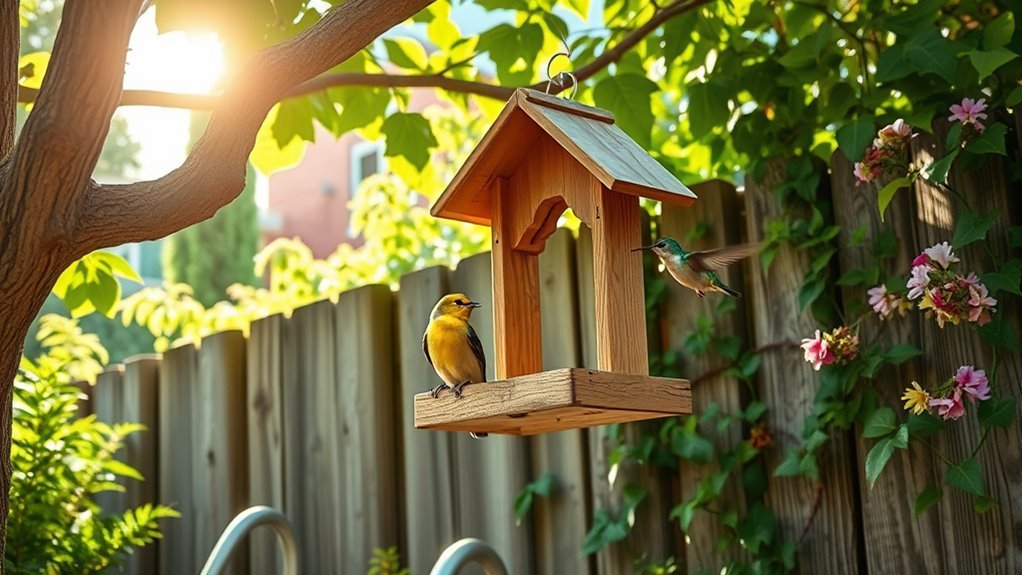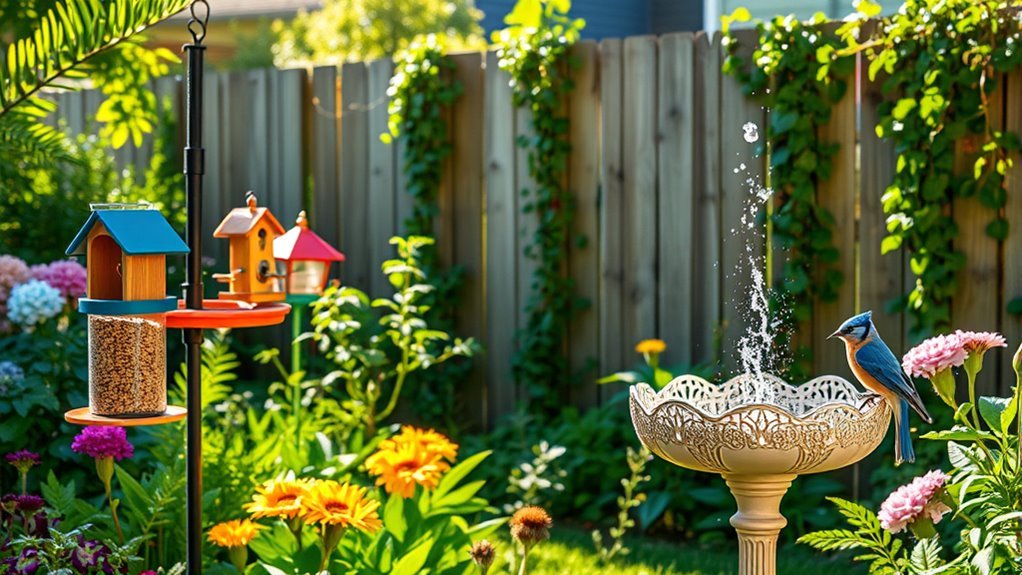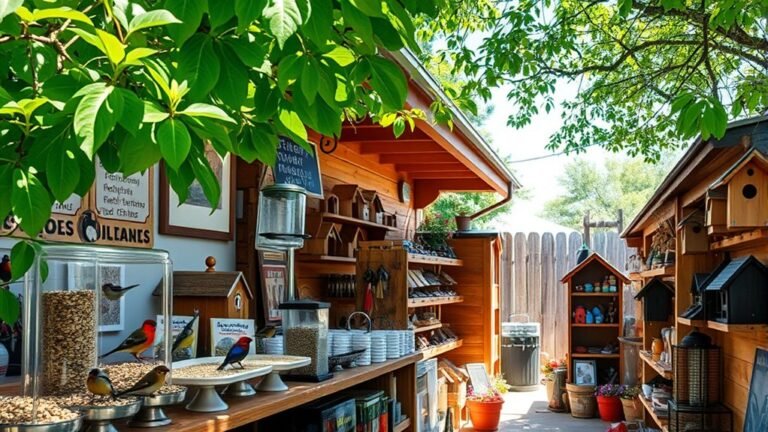New York Local Backyard Bird Guide
In New York backyards, you can find many bird species, each with unique behaviors and traits. Learning about these birds can improve your birdwatching experience. For example, the common House Sparrow often visits feeders, while the more hidden Song Sparrow prefers thick shrubs. Each bird contributes to the local environment. By observing their habitats and actions, you can discover simple ways to attract and identify them in your yard. What interesting birds might you find right at home?
Key Takeaways
- New York backyards host diverse birds like House Sparrows and Song Sparrows, essential for the ecosystem.
- Attract birds by installing feeders with preferred seeds, providing water sources, and incorporating native plants.
- Optimal birdwatching times are early mornings and late afternoons when bird activity peaks.
- Identify birds by observing their physical traits, behaviors, and listening for unique calls.
- Join local birdwatching groups to expand your knowledge and enhance your backyard birdwatching experience.
Overview of Backyard Birdwatching in New York

Your backyard in New York is home to many bird species. These birds play important roles in the ecosystem.
Watching birds in your backyard helps you learn about how birds live and interact with their environment. You can see how they connect with plants, deal with pests, and respond to seasonal changes. This experience fosters a sense of how everything is linked in nature.
Birdwatching also grows your appreciation for the natural world and the importance of keeping it diverse. By creating a welcoming space for birds, you participate in a rewarding hobby that also supports the health of your local ecosystem.
This connection with nature enriches your life.
Common Bird Species Found in New York Backyards
In New York backyards, you can see many bird species that add to the area's diversity. Common sparrows, like the House Sparrow and Song Sparrow, are frequently spotted.
The House Sparrow makes chattering calls, while the Song Sparrow sings melodious tunes. These sounds create lively backgrounds for birdwatchers.
Watching these birds helps you learn about their feeding habits and nesting behaviors, which change with the seasons.
Sparrows often forage in small groups, showing their social nature. Learning about these common species helps you understand local ecosystems and build a stronger connection to nature right in your backyard.
Attracting Birds to Your Backyard

To attract birds to your backyard, create a welcoming environment that resembles their natural habitat.
First, install bird feeders with food that local birds enjoy. Use sunflower seeds for small birds and suet for woodpeckers. Place your feeders near trees or shrubs for safety.
Next, add water sources. A birdbath or shallow dish can provide drinking and bathing spots. Keep the water clean and fresh.
Provide shelter for birds with native plants, shrubs, or trees. These plants offer cover from predators and nesting spots. You can also place birdhouses in quiet areas, ensuring they meet the needs of specific bird species.
Bird Feeding Tips for Your Backyard
Bird feeding requires careful thought about the food and feeders you use. The right choices can attract more birds to your backyard. Use seed types like sunflower seeds, nyjer seeds, and suet to draw different bird species.
Each type of bird has its own food preferences, so offering a variety creates a lively birdwatching environment.
Feeder placement matters too. Put feeders near bushes or trees to give birds shelter from predators. Also, place them in open spaces for easy takeoff and landing.
Clean your feeders regularly to avoid disease and keep your backyard an inviting place for birds. With these tips, you can enjoy watching a diverse range of birds visit your yard.
Creating a Bird-Friendly Habitat

Creating a bird-friendly habitat in your backyard is simple and rewarding.
Start by adding native plants that provide food and nesting materials for local birds. Plants like coneflowers and black-eyed Susans attract both birds and pollinators.
Next, include water sources like birdbaths or small ponds. Make these features shallow and clean them regularly. Birds need fresh water to drink and bathe.
Reduce pesticide use in your garden. Fewer pesticides mean more insects, which are vital food for birds at different stages of their lives.
By adding these features, you create a welcoming space for birds.
Enjoy the beauty of nature and the company of your feathered friends.
Seasonal Birdwatching: What to Expect
How do changing seasons improve your birdwatching experience? Each season offers different migration patterns and behaviors, enhancing your encounters with birds.
In spring, colorful songbirds return from warmer regions. Their mating calls fill the air with beautiful sounds.
Summer brings nesting activities, where you can observe parents feeding their young and protecting their territory.
In autumn, birds gather in large flocks, creating exciting sights.
Winter allows you to see how resident birds adapt to cold weather by conserving energy and finding food.
Tips for Identifying Backyard Birds
To identify birds in your backyard, focus on key factors. First, observe their physical traits. Each bird species has unique colors, patterns, and sizes. For instance, a bright red cardinal stands out against the brown of a sparrow.
Next, note their behavior. How a bird feeds or moves can help you recognize it. Listen to their calls and songs; each species typically has a distinct sound.
Keep a notebook ready to record your findings. This practice can improve your skills over time. Joining local birdwatching groups can also enrich your knowledge and enjoyment of birdwatching.
Best Time for Birdwatching
Birdwatching is most rewarding during the early morning and late afternoon. In the morning, birds are active as they search for food and sing to mark their territory.
Cool temperatures and calm winds improve visibility and sound, making it easier to observe them. The rising sun highlights their bright colors, simplifying identification.
In the late afternoon, birds become active again as they prepare to roost. This time is ideal for watching how they feed and interact with each other.
Knowing the best times to observe birds can enhance your birdwatching experience and help you feel more connected to nature and the birdwatching community.
Resources for Birdwatching Enthusiasts
To improve your birdwatching experience, gather the right resources. Start with good binoculars that offer a wide field of view and clear images. This will help you spot birds more easily.
Use field guides focused on New York's birds to identify different species accurately.
Consider joining local birdwatching clubs. These groups host events, workshops, and outings. Joining is a great way to learn from others and meet new friends who share your passion.
Engaging with fellow birdwatchers allows you to exchange tips and stories, enriching your hobby.
Frequently Asked Questions
What Types of Birds Migrate Through New York in Spring and Fall?
In spring, you will see many colorful warblers and orioles migrating north. During fall, hawks and sparrows arrive as they travel south. Each bird species changes its route due to changing weather. This creates a lively environment for birdwatchers and nature lovers in New York. Enjoy observing the variety of birds as they journey through the seasons.
How Can I Tell if a Bird Is Sick or Injured?
To check if a bird is sick or injured, watch its behavior closely. Look for signs like being less active, puffed-up feathers, or trouble flying. These symptoms indicate that the bird may need help. Acting quickly can improve its chances of recovery and strengthen your bond with nature. Pay attention to the bird's needs and take action when necessary.
Are There Any Laws About Feeding or Housing Wild Birds in New York?
In New York, you can generally feed wild birds without many restrictions. However, be careful not to attract pest species like raccoons or rats. When it comes to housing birds, there are rules for certain species. It's important to check local laws to ensure you are following the guidelines while still enjoying the presence of birds in your area.
Can I Attract Specific Bird Species to My Backyard?
To attract specific bird species, use bird feeders that match their food preferences. Include native plants to offer shelter and food. These additions will create a friendly environment and increase the variety of birds in your backyard. Enjoy watching the different species visit your space!
What Are the Best Times of Day for Birdwatching in New York?
To enhance your birdwatching experience, go out in the early morning or late evening. During these times, birds are most active. You will have the chance to see various species as they search for food and interact with one another. Enjoy the beauty of nature while observing these fascinating creatures in their natural habitat.

Hello, I’m Amelia White, the founder of birdsfanatic.com. As a lifelong bird enthusiast and spiritual seeker, I’ve always been fascinated by the mystical connections between birds and the human experience. On this site, I share my knowledge and insights into the symbolic meanings and spiritual significance of various bird species, exploring their roles in mythology, folklore, and cultural traditions. Join me on this journey into the world of birds, where we’ll discover the hidden wisdom and guidance that these magnificent creatures have to offer.







